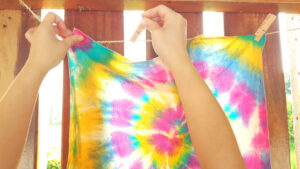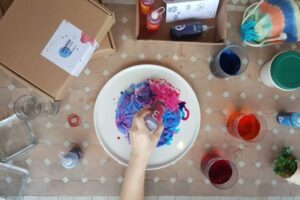Fabric Dyeing Techniques for Beginners: Tie-Dye, Shibori, and Ombre Guide
Fabric dyeing is a blend of art and science that infuses color into textiles. Whether it’s tie-dye, shibori, or ombré dyeing, these techniques not only give fabrics unique visual effects but also showcase the creativity and individuality of the artist. In this article, I will introduce the basics of dyeing and three popular techniques to help you explore the charm of fabric dyeing from scratch.

1. Basics of Fabric Dyeing
1. What is Fabric Dyeing? Fabric dyeing is the process of bonding dye to textile fibers through chemical or physical means. The fundamental principle is utilizing the fiber’s absorbency to allow dye molecules to adhere securely. Common dyeing methods include immersion dyeing, spray dyeing, and printing.
2. Choosing Suitable Materials Different fabrics vary in their ability to absorb and display colors. Natural fibers like cotton, linen, and silk are ideal for dyeing due to their excellent absorbency, while synthetic fibers like polyester usually require special dyes. Understanding material characteristics helps us select the most appropriate dyeing technique.
Dyeing Methods for Different Fabrics:
- Cotton: Ideal for tie-dye, shibori, and ombré dyeing due to its strong absorbency and easy handling.
- Linen: Often used with natural or plant-based dyes for a rustic, organic look.
- Silk: Best suited for low-temperature dyeing techniques like shibori to preserve its delicate structure.
- Polyester: Requires disperse dyes and high-temperature dyeing to fix colors.
- Wool: Suitable for ombré dyeing with acid dyes; low-temperature handling is essential to prevent felting.
2. Tie-Dye Technique
1. Historical Background of Tie-Dye Tie-dye is an ancient manual dyeing technique originating from regions like China and India. By binding fabrics to restrict dye spread, tie-dye creates distinctive patterns. Beyond being a decorative method, it carries deep cultural significance.
2. Basic Steps of Tie-Dye The process is relatively simple yet full of creative possibilities.
- Material Preparation: Gather fabric, dye, rubber bands, gloves, etc.
- Binding Techniques: Common methods include binding, twisting, and folding to create classic patterns like circles, spirals, and stripes.
- Applying Dye and Fixing Colors: Apply dye evenly to the fabric, then use heat or fixatives to set the colors.
3. Creativity and Variations in Tie-Dye By combining various binding techniques and dye colors, you can create unique patterns. Consider adding gradient effects or integrating hand-painted elements to personalize your designs.

3. Shibori Technique
1. Overview of Shibori Shibori is a traditional Japanese dyeing craft that involves twisting, folding, and stitching fabric to create intricate patterns. It emphasizes layering and fine detailing in its designs.
2. Basic Steps of Shibori
- Materials and Tools: Fabric, natural or chemical dyes, strings, and wooden boards.
- Common Techniques:
- Twisting: Twist the fabric into spirals and secure it.
- Fold-and-Clamp: Fold the fabric repeatedly and clamp it with clips.
- Color Selection: Layered dyeing enhances the depth and texture of patterns.
3. Creative Applications of Shibori Shibori is perfect for clothing, home decor, and art pieces. For instance, applying this technique to curtains, cushions, or scarves makes them both functional and artistic.
4. Ombré Dyeing Technique
1. Charm of Ombré Dyeing Ombré dyeing is famous for its smooth color transitions, making it a trendy design choice. It’s often used to create natural, flowing visual effects.
2. Dyeing Process of Ombré
- Material Preparation: Gather fabric, dye, dyeing containers, and stirring tools.
- Dyeing Steps:
- Immersion Method: Gradually dip the fabric into dye, adjusting immersion time for color gradients.
- Spray Method: Use a spray bottle to apply dye layer by layer.
3. Creative Design in Ombré Dyeing Color combinations are key in ombré dyeing. For example, contrasting warm and cool tones create striking effects, while monochromatic gradients exude elegance. Use ombré dyeing for dresses, shawls, or art projects to elevate the overall design.
5. Safety and Environmental Considerations
1. Safety Measures During Dyeing
- Wear gloves and aprons to avoid direct contact with dyes.
- Work in a well-ventilated space to minimize inhaling chemicals.
- Dispose of wastewater responsibly to prevent environmental harm.
2. Recommendations for Eco-Friendly Dyes Prioritize natural dyes, such as plant extracts. If using chemical dyes, look for eco-friendly certifications. Reading product labels and consulting suppliers can help identify safer materials.
6. Conclusion
Fabric dyeing offers endless possibilities and is an excellent way to showcase personal creativity. Whether tie-dye, shibori, or ombré dyeing, each technique is worth exploring. For deeper learning, consider professional books or online courses.
Start your dyeing journey and turn every piece of fabric into a work of art!
Customizing your own clothes is an exciting way to grow your business and offer unique products to your customers. By following these steps, you can turn your ideas into reality.
Ready to get started? Contact Dongguan Yimeng Garment Co., Ltd. today for expert guidance and reliable manufacturing services. Let us help you bring your vision to life!
CTA:
- Email: [carolinapparel@163.com]
- WhatsApp: +86-15322920913
- instagram:https://www.instagram.com/ymgarment/
- Click here to get a free consultation!







